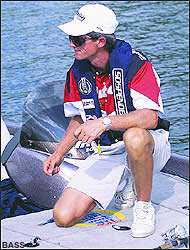
Ask a group of avid bass fishermen to define the term "strike zone" and you'll get a variety of answers.
"The strike zone is how far the fish will come to attack a bait, to aggressively get it," said Kevin Wirth, a five time CITGO Bassmaster Classic qualifier from Kentucky. "It is probably the most critical thing you can determine on any day. Really, what you're asking yourself is: What's the mood of the bass?"
For Wirth, the answer varies somewhere between the simple and the complex.
"To me, that all plays with your weather conditions and things like barometric pressure. Sometimes it's availability of cover. If you're looking at availability of cover and it's real thick cover, your strike zone is going to be smaller.
"When you get a little bit thinner cover, your strike zone tends to increase (in size). That, therefore, can also depend on the color of the water. The clearer the water, the bigger the strike zone. You can draw them from farther away and you don't have to let them see your bait as much to get a bite. The dirtier the water, the closer you need to get it to the fish."
Defining the strike zone on paper is considerably more difficult than determining exactly where it exists in a single day. The variation of weather, water, cover and all the other factors that can affect it can be mind-boggling.
Wirth paused during a CITGO Bassmaster Tour event recently to explain the diversity of elements involved in establishing a strike zone.
"In this particular tournament, the color of the water and the availability of cover seem to be most important. It will probably be won on water lilies or hyacinths with a mixture of some type of grass and the canes. The fish are very far in the grass, so you know your strike zone is going to be very small.
"So, you're going to have to bounce some fish on the head to get a bite. Basically you're down to one tactic to get there and that's flipping. If you make your flips 5 feet apart you might be in danger of missing the fish. The strike zone is so small that you need to cover the water very thoroughly in this situation."
Establishing the perimeters of a strike zone is considerably easier in shallow water because deep water requires more time to reach and explore. Also, when working shallow visible cover, it's far simpler to visualize the bass' positioning in cover (or adjacent to targets), as well as the depth range they are utilizing.
One of the most mystifying aspects of strike zone fishing is that it can change from hour to hour, not to mention day to day.
"I've seen it happen many times, especially with wind conditions and sunlight conditions," the BASS winner explained. "I've had times that you think the strike zone is going to be really big early in the morning and then later on in the day, but it's actually worked the opposite because the conditions have changed.
"The strike zone has really broadened out in the day versus a little tighter in the morning. That all could even be due to high barometric pressure or low barometric pressure."
Determining the strike zone on any given day is tough enough without the challenge of adjusting to it changing several times. Being able to recognize when it has changed is one of the differences between professional anglers and others.
"I think it comes down to instinct or maybe just time on the water," Wirth continued. "Just understanding that it does change is important. It's just something that might be a little bit hard to describe other than looking at your weather conditions or what's coming up, the color of the water and the cover availability."
The bottom line? Depending on the conditions, the actual size of a strike zone varies. In deep water, for example, it may be large enough to allow an angler to mop up with a fast moving crankbait. Other times, it will be so small that getting a reaction might require a more precise presentation with a Caroling rigged plastic.
Nothing is easy when it comes to determining — and staying on top of — the strike zone.




